A New Era of Humanity: The Geography of the "Anthropocene" Era
EnglishNorbert CsizmadiaThe World in 100 MapsBenjamin D. Hennig, a professor of geography at the University of Iceland in Reykjavik, drew a new Anthropocene world map of humanity that looks like the following picture.
Map of the Anthropocene World
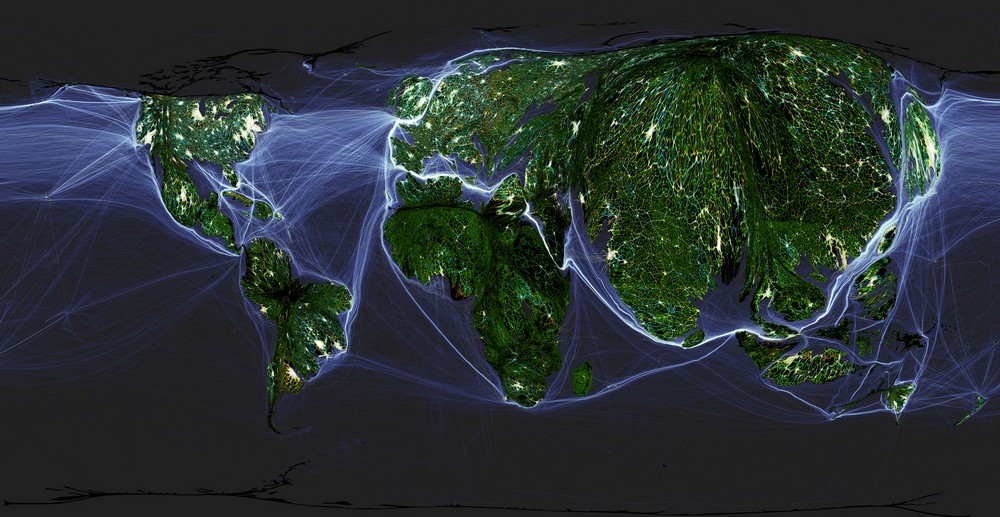
Source: Benjamin Henning, 2017
Human population and economic development, as part of the processes of globalization, have a major impact on the natural environment. Part of our footprint is the major communications and transportation infrastructure connections that shape the human planet. On this unique map, cities are highlighted in white, roads in green, railways in orange, pipelines in red, and major maritime trade routes and submarine internet cables in light blue. The map is also interesting in that the larger the population, the larger the area that appears in a given country, which is why China and India appear so defined in this map representation.
After about 11,000 years of Holocene, we have entered a new age of earth history: the "age of a man-made environment," that is, the age of the Anthropocene.
Nobel laureate Paul Crutzen, who introduced the latest epoch of earth history, the term "Anthropocene," passed away on January 28, 2021. The definition itself was led by ecologist Eugene F. Stoermer in the 1980’s, but was disseminated by Nobel Prize-winning atmospheric chemist Paul Crutzen. Crutzen believed that the impact of human factors on the Earth’s atmosphere was so significant that a new age of earth history needed to be created. All this happened in 1999, based on a proposal made at the International Geosciences Conference in Cape Town, South Africa.
From Holocene to Anthropocene
Man appeared 1.2 million years ago, and 11,700 years ago the climate also became suitable for the begining of a new era of earth history, called the Holocene period.
Our earth formed its present landscape geography and wildlife by the Holocene period. An important feature of the Holocene is the growing role of man in its formation. Today, however, humanity has become an important factor in shaping the planet.
But when can we expect the Anthropocene era? In this, so far there is no scientific concurrence. Some scientists would count the appearance of the first civilization, others would date it back to the year 1610, or link the date to the time of the first experimental nuclear explosion (July 1945), but there are also researchers who reckon the Anthropocene from 1964. The latter is also obvious because looking at where there is a fault line based on 24 factors (from the population growth to the emergence of McDonald’s restaurants, urban population share, car penetration, GDP growth, water use, travel and tourism) where the growth starts, the figure nicely shows the drastic growth from the 1960’s.
The Beginning of the Anthropecene Era Based on 24 Factors
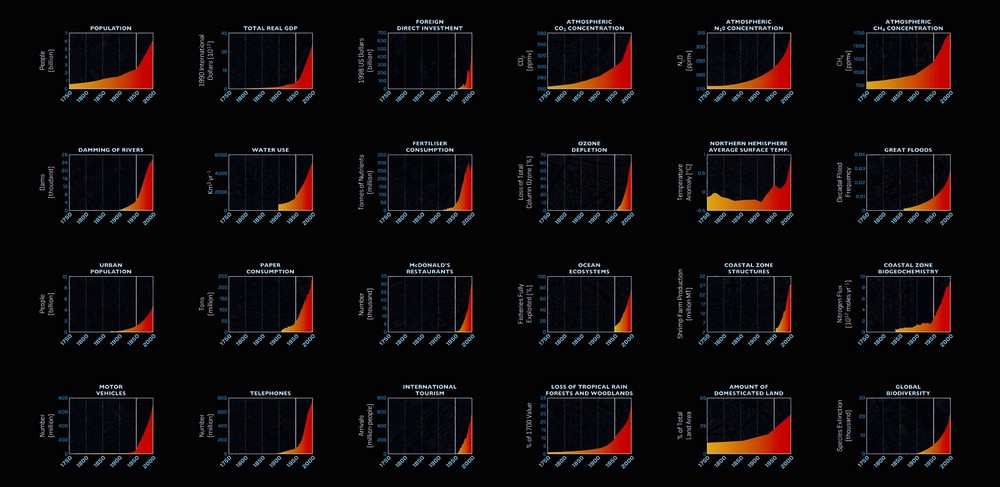
Source: Nemzetközi Geoszféra és Bioszféra program, design: Globaia.org
Acknowledging the new era, scientists say, is justified because humanity has left traces that have already reached the level of natural influences - we have irrevocably reached into life on Earth.
In the middle of the 20th century, we find a "geological stratum boundary" that clearly separates the Holocene from the most recent, Anthropocene era. The spread of aluminum and plastics, the drastic increase in population, the onset of global warming, the onset of anthropogenic climate change, and the increasing extinction of species began and continued at this time. The differences compared to the Holocene, this stable age of 11,000 years, are significant. Manmade impacts include climate change, large-scale changes in the carbon, nitrogen, and phosphorus cycles.
“We are the first generation to recognize global threats to humanity”
– said Mario Molina, a spokesman for Nobel Prize-winning chemists.
The most important challenge is that the rate of global warming should be limited to a maximum of 2 degrees Celsius per year. This is mainly achieved by drastically reducing CO2 emissions.
One Minute Before Midnight
The growing population of humanity and the increasing diversity and intensity of human activity have transformed our planet in a way that is perceptible on earth history, and its resources are being rapidly devoured. To illustrate the dramatic speed of the process, compare the time dimension of human existence with the age of the Earth.
If we consider the 4.6 billion-year-old history of the Earth to be as 24 hours time, then life appeared at four in the morning and humanity appeared at 23 hours 58 minutes and 43 seconds.
The Anthropocene is the current age of earth history, defined by the effects of human activity on Earth, and began with the invention of the first industrial revolution, the steam engine, when humanity made tremendous progress in evolving and transforming its environment.
The most striking increase and perhaps the most serious, with complex consequences of human-induced greenhouse gas concentrations in the process, causing the earth's average temperature to be 0.8 ° C since the Industrial Revolution was increased. Moreover, a number of other unfavorable and ultimately destructive processes have begun to destroy human living conditions, 13 million hectares of forests are being converted into agricultural land in South America, Africa and East Asia each year; the world's seas are 30% more acidic today than they were in the 18th century; there are 6 billion kilograms of waste per year. Mostly plastics pollute the oceans and their decomposition time can be as long as several centuries, depending on the type. Damage to natural habitats has killed 40% of the Earth’s animal population in the last 40 years.
The ecological footprint of our earth
The complex impact of individual countries on the environment can be expressed in terms of the ecological footprint. The value of the ecological footprint indicates how much land and water a human society (or individual) needs to sustain itself and absorb the waste produced at a given technological development, i.e., how much it burdens the natural environment. The primary goal of the indicator is mostly to raise awareness and raise awareness of resource conservation in industrialized countries.
The U.S. is also "at the forefront" of the ecological footprint per capita. While its population is less than 5 per cent of the earth’s population, it accounts for 25 per cent of resource use and 30 per cent of waste generation.
If all the people in the world followed this way of life, they would need six Earths to survive.
The rest of the developed world, as well as those living in Russia and the oil states of the Arabian Peninsula, are not far behind the USA in terms of ecological footprint. Meanwhile, China, India and Indonesia have a per capita ecological footprint of less than 180 global hectares.
Our Earth’s ecological footprint by country and per capita carbon emissions
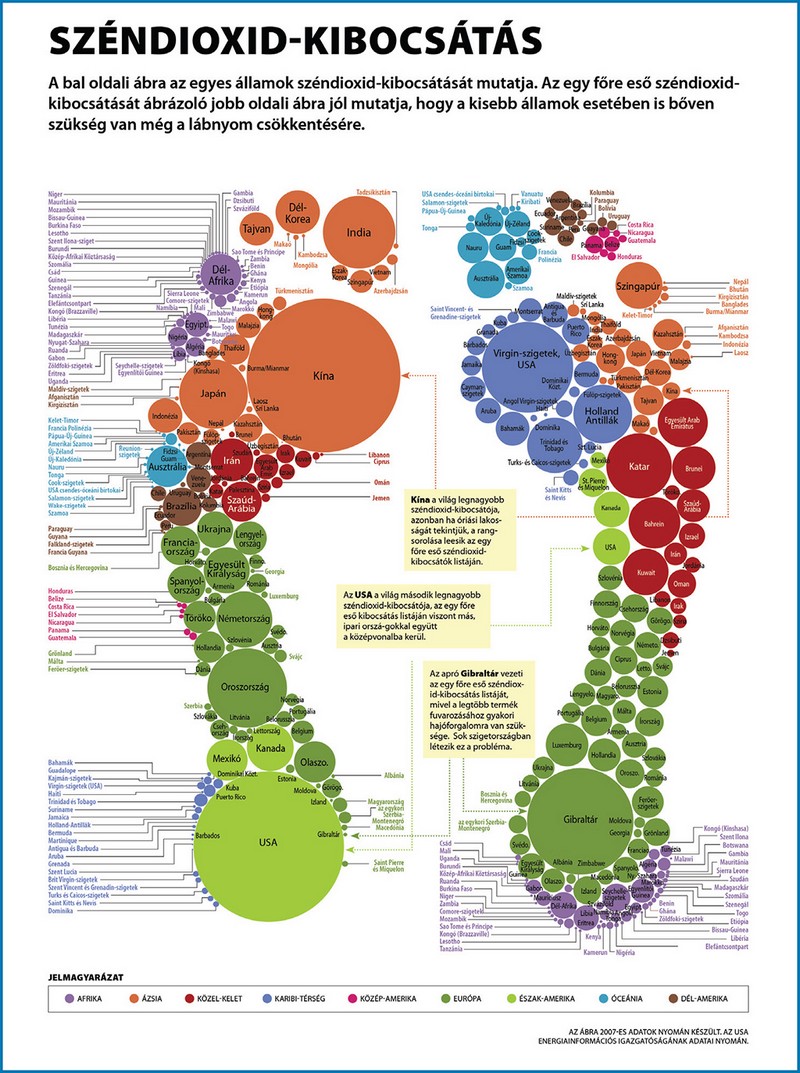
Source: Geopillanat - a 21. század megismerésének térképe
What would our world look like today if only 100 people lived?
When the world’s population reached 7 billion in 2011, the100people.org repeated Donella Meadows ’1990 study of one of the pioneering researchers in American environmental sciences, in which Donella Meadows mapped the characteristics of the world’s population into a group of 100 people, showing the world’s population by gender, age group and cultural and ethnic characteristics.
According to the interesting result, there would be 50 women and 50 men living on Earth, 26 of whom would be children and 74 adults, of whom only 8 would be over 65 years of age. 60 would live in Asia, 15 in Africa, 14 in America and 11 in Europe.
As far as religion is concerned, 33 would be Christian, 22 would be Muslim, 14 would be Hindu, 7 would be Buddhist, 12 would be of other religions and 12 would be without a religion. 48 out of a hundred people would earn less than 2 dollars a day. There would only be 7 people with a university degree. 22 would own or share a computer, 77 would use a cell phone, and there would be 30active Internet users.
If the World Consisted Only of 100 People
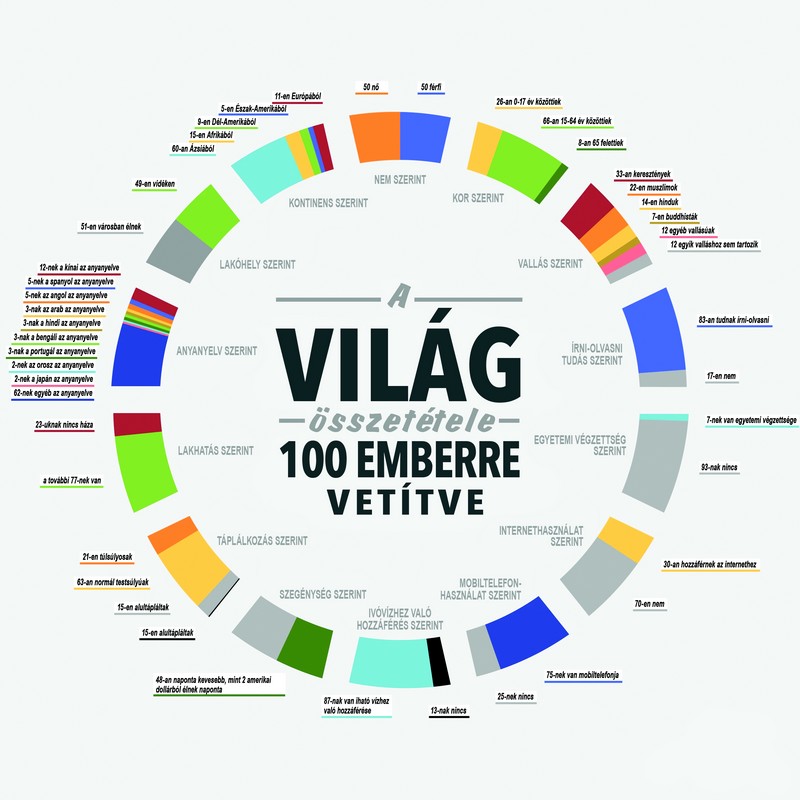
Source: Geopillanat – A 21. század megismerésének térképe
A Map of the Anthropogenic World in a Different Light
Mapping Human Impacts: A Biological Map of our Earth
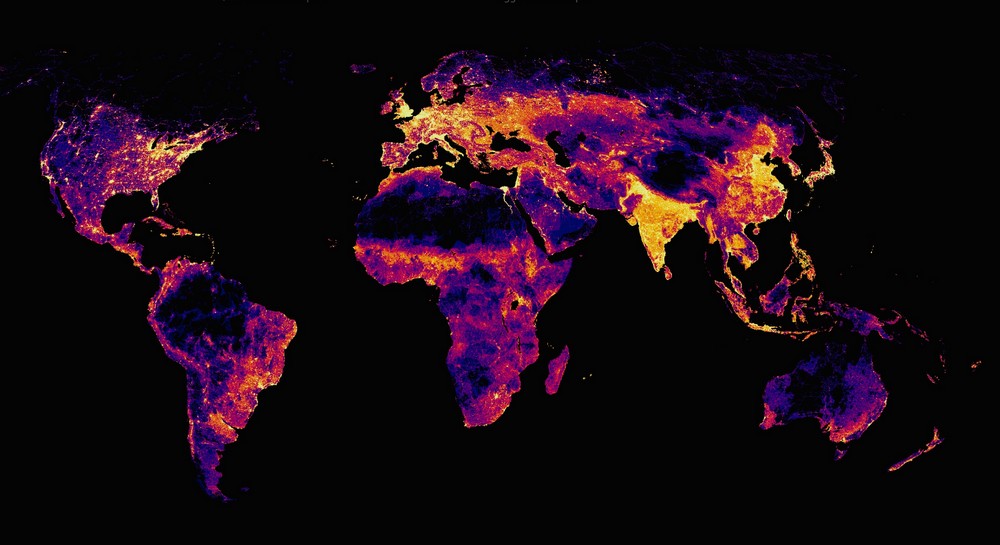 Source: LE PAN, Nicholas (2020): Visualizing the Human Impact on the Earth's Surface
Source: LE PAN, Nicholas (2020): Visualizing the Human Impact on the Earth's Surface
Human activity has always had an impact on our Earth. According to Hannah Ker’s research, nearly 95% of the Earth’s surface shows some form of transformation linked to human activity. This world map shows us in which areas within the terrestrial system humanity has intervened best, mostly the areas that are marked in yellow.
The world's land surface is only:
⦁ 5% has not been converted by humans, amounting to almost 7 million km². By comparison, the Sahara covers an area of 9 million km², the Amazon Basin covers an area of 7.5 million km² and the European continent covers an area of 10.5 million km².
⦁ The research categorized 4% (5.5 million km²) with significant changes. These are the areas marked in yellow on the map and the most industrialized and densely populated areas of our Earth. The latter category includes the central regions of China, India and Italy.
⦁ 44% (59 million km²) low change was identified;
⦁ 34% medium - purple - (46 million km²);
⦁ 13% identified a high (17 million km²) change.
The so called “stress factors” caused by the most determined transformations created by mankind, include human settlements, built-up areas, agriculture, transport, mining and energy production, and electrical infrastructure.
Researchers have also differentiated so-called biomass units. Biomes are biological communities that have evolved in response to a common physical climate.
Of the biomass studied, the least modified biomasses are the tundra, northern forests, deserts, and temperate coniferous forests and mountain grasslands. In contrast, tropical dry broadleaf forests, temperate broadleaf forests, Mediterranean forests, mangroves, and temperate grasslands are the most modified biomasses. The denser network of settlements, agricultural land use, infrastructure network and industrial activities dominate the more modified biomasses, which is also indicated in yellow by the map above. These areas threaten the balance of the naturally occurring ecosystem services.
Our world has entered a new era, the Anthropocene era. The most important changes have been formed by us humans, so in the long run, it is critical that we put things in order and balance, thus the most vital challenge for the future will be sustainability so that future generations can use this amazing blue planet of life!
The author is the chairman of the board of trustees of the Pallas Athene Domus Meriti Foundation (PADME).
